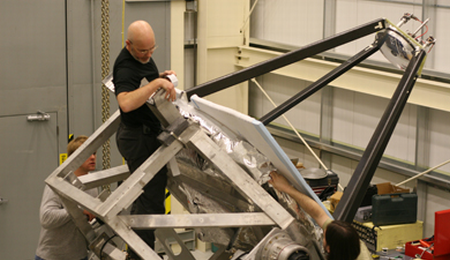Just before Christmas in 2006, Mark Devlin, the Reese W. Flower Professor of Astronomy and Astrophysics, led a team of scientists to launch a telescope that would scrutinize the heavens in search of primeval galaxies at the far reaches of the universe. The multimillion-dollar instrument was about the size of a Hummer, and it hung by a cable from a football-stadium-sized balloon that floated to the very edge of space. (Big, high-flying balloons are considerably cheaper and faster to build than rockets and satellites.) For 11 days, the Balloon-borne Large-Aperture Sub-millimeter Telescope drifted 25 miles above the South Pole taking deep-space pictures. BLAST’s mission, to collect sub-millimeter light waves from galaxies formed in the early universe, was the culmination of eight years work designing, building and testing the innovative instrument.
“The overriding theme behind all my experiments in cosmology,” Devlin says, “is understanding how the universe got to be the way it is over 13 billion years.” Devlin is building a new and improved BLAST for future light-gathering flights, and he recently completed work on the Atacama Cosmology Telescope, a prodigious light collector that sits on a mountaintop in Chile.
Now, after two years of poring over surveys and sky maps from BLAST’s Antarctica flight, Devlin and his collaborators have started to publicize their discoveries. In a paper in Nature, the BLAST team confirmed that the dim glow astronomers had detected more than a decade ago—the Far Infrared Background radiation that covers the entire sky—is in fact myriad giant galaxies, brilliantly illuminated by new stars bursting into life.
The light from these far-off celestial objects started on its cosmic journey billions of years ago and is just arriving in the neighborhood of earth, which means that BLAST looks back into time—more than half way back to the big bang—to photograph very young galaxies. “These early galaxies would have crashed together, and this crashing would have stimulated a huge amount of star formation in that new galaxy that’s being created,” Devlin observes. “One of these early galaxies is just a completely different beast” from our own. “Starburst” galaxies erupt with hundreds of new suns every year; today’s galaxies give birth to maybe two or three. At its peak, a starburst galaxy could achieve luminosity 1,000 times greater than the Milky Way, and as much as half the light energy illuminating the cosmic night seems to come from the brilliant beasts of the young universe.
The great clouds of dust that feed star formation in these luminous structures hide the visible light they emit, but sub-millimeter wave lengths get through. Because it rises above the atmosphere, which absorbs sub-millimeter light, BLAST discovered more than 10 times as many starburst galaxies in just a few days as ground-based observers had found in a decade. And the BLAST team could describe them in much finer detail.
“By understanding how stars are forming, we can start to understand how our universe evolved,” he says. “The evolution of the universe is a very complicated problem. Without information like we’re seeing with BLAST, we wouldn’t be able to figure out the puzzle.”



